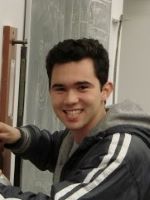
Ph.D. in Chemistry, Rice University (2015)
B.S. in Engineering Physics, Tecnologico de Monterrey, Mexico
Research Interests
Interaction of proteins with nanoparticles
Nanoparticles suspended in biological fluids such as blood plasma adsorb proteins onto their surface leading to the formation of what is called a protein ‘corona’. Adsorbed proteins on nanoparticles change the original ‘identity’ of the nanoparticle surface ultimately determining the physiological response and signaling pathways at the cellular level. Because of the promising therapeutic and diagnostic applications of nanoparticles it is imperative to understand the impact of the the formation of this protein corona on both colloidal stability and protein structure.
In the Link lab we are applying optical microscopy techniques to study this ‘corona’ in situ and in real time. We expect to obtain a physico-chemical understanding of the protein corona and visualize its dynamics and evolution over time. We have started this goal by studying the interaction of bovine serum albumin (BSA, a cow analog of human serum albumin, the most abundant protein in circulation) and citrate-stabilized gold nanospheres.
We have determined the equilibrium dissociation constant (KD) of the interaction using scattering correlation spectroscopy, an experimental technique that allows measuring the hydrodynamic dimensions of nanoparticles while freely diffusing in solution. The figure below shows the characteristic decay time of an autocorrelation curve of the scattering signal of gold nanopsheres without and with the presence of BSA (A). The observed increase in the characteristic diffusion time in the presence of protein can be translated to monolayer adsorption of BSA onto the nananoparticle surface (A-inset). By varying the concentration of BSA in solution we can perform an adsorption isotherm and measure the increase in hydrodynamic radius as a function of protein concentration and extract the equilibrium dissociation constant of the interaction (B). In addition, we can count the number of individual scattering events (proportional to the number of nanoparticles sampled in solution) per autocorrelation curve and assess the impact of proteins on colloidal stability (C-D).
We have found that BSA not only does not lead to aggregation of citrate-stabilized gold nanoparticles (by observing the same of events without and with the presence of BSA), but also offers remarkable protection against aggregation under highly saline conditions of up to 1 M of NaCl.
Dissertation
Publications
- S. Dominguez-Medina, L. Kisley, L. J. Tauzin, A. Hoggard, B. Shuang, A. S. D. S. Indrasekara, S. Chen, L. -Y. Wang, P. J. Derry, A. Liopo, E. R. Zubarev, C. F. Landes, and S. Link, Adsorption and Unfolding of a Single Protein Triggers Nanoparticle Aggregation, ACS Nano 10, 2103 (2016).
- S. Dominguez-Medina, S. Chen, L. J. Blankenburg, P. Swanglap, C. F. Landes, and S. Link, Measuring the Hydrodynamic Size of Nanoparticles using Fluctuation Correlation Spectroscopy, Annual Review of Physical Chemistry, 67, 489 (2016).
- J. Olson, S. Dominguez-Medina, A. Hoggard, L.-Y. Wang, W. -S. Chang and S. Link, Optical characterization of single plasmonic nanoparticles, Chem. Soc. Rev 44, 40 (2015).
- J. Yeom, B. Yeom, Henry Chan, K. W. Smith, S. Dominguez-Medina, J. H. Bahng, G. Zhao, W.-S. Chang, S.-J. Chang, A. Chuvilin, D. Melnikau, A. L. Rogach, P. Zhang, S. Link, P. Král and N. A. Kotov, Chiral templating of self-assembling nanostructures by circularly polarized light, Nat. Materials 14, 66 (2015).
- D. Huang, C. P. Byers, L.-Y. Wang, A. Hoggard, B. Hoener, S. Dominguez-Medina, S. Chen, W.-S. Chang, C.F.Landes and S. Link, Photoluminescence of a Plasmonic Molecule, ACS Nano 9, 7072 (2015).
- L.-Y Wang, K. W. Smith, S. Dominguez-Medina, N. Moody, J. M. Olson, H. Zhang, W.-S. Chang, N. Kotov, and S. Link, Circular Differential Scattering of Single Chiral Self-Assembled Gold Nanorod Dimers, ACS Photonics 2(11), 1602 (2015).
- L. S. Slaughter, L.-Y. Wang, B. A. Willingham, J. M. Olson, P. Swanglap, S. Dominguez-Medina, and S. Link, Plasmonic polymers unraveled through single particle spectroscopy, Nanoscale 4, 11451 (2014).
- S. Dominguez-Medina, J. Blankenburg, J. Olson, C. F. Landes, S. Link, Adsorption of a Protein Monolayer via Hydrophobic Interactions Prevents Nanoparticle Aggregation under Harsh Environmental Conditions, ACS Sustainable Chemistry & Engineering 1, 7, 833 (2013).
- W.-S. Chang, B. Willingham, L. S. Slaughter, S. Dominguez-Medina, P. Swanglap, S. Link, Radiative and Nonradiative Properties of Single Plasmonic Nanoparticles and Their Assemblies, Acc. Chem. Res. 45, 1936 (2012).
- S. Dominguez-Medina, S. McDonough, P. Swanglap, C. F. Landes, S. Link, In situ measurement of bovine serum albumin interaction with gold nanospheres, Langmuir 28, 9131 (2012).
- Y. Fang, W.-S. Chang, B. Willingham, P. Swanglap, S. Dominguez-Medina, S. Link, Plasmon emission quantum yield of single gold nanorods as a function of aspect ratio, ACS Nano 6, 7177 (2012).
- A. Tcherniak, S. Dominguez-Medina, W.-S. Chang, P. Swanglap, L. S. Slaughter, C. F. Landes, S. Link, One-photon plasmon luminescence and its application to correlation spectroscopy as a probe for rotational and translational dynamics of gold nanorods. J. Phys. Chem. C 115, 15938 (2011).
- A. Tcherniak, J. W. Ha, S. Dominguez-Medina, L. S. Slaughter, S. Link, Probing a century old prediction one plasmonic particle at a time, Nano Lett. 10, 1398 (2010).